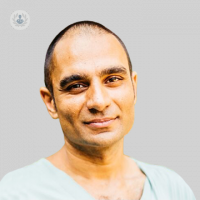A specialist explains: cholesteatoma essentials
Escrito por:Though one of the smallest parts of the body, the eardrum and bones in the ear are important for our hearing ability. There are a multitude of conditions that can impact this ability, one being a cholesteatoma. In this article, expert consultant ENT surgeon Professor Mahmood Bhutta clarifies what it is and why it is important to have it taken care of.

What is a cholesteatoma?
A cholesteatoma is an abnormal growth arising from the skin of the eardrum. It grows inwards and will slowly destroy the bone of the skull around the ear. Once it starts it doesn’t stop, and it can damage the bones of hearing, the balance organs, or even spread to cause potentially life-threatening infection in the brain.
How does a cholesteatoma form?
Nobody really knows. They affect about 1 in every 10,000 people every year and mostly arise in people who have had problems with ear infection or inflammation earlier in life. We think that persistent inflammation causes the biology of the eardrum to go wrong, and so the skin starts growing inwards rather than outwards like normal.
What do they feel like?
Often, they cause mild symptoms in the early stages. There may be a bit of discharge from the ear from time to time, some mild pain, and eventually there will be some hearing loss. An ear that has these sorts of persistent symptoms really needs to be examined.
How is a cholesteatoma diagnosed?
The diagnosis is made by an expert looking in the ear in the clinic. If we see skin growing inwards from the ear drum, it’s a cholesteatoma. Sometimes it can be difficult to see what’s going on, and so occasionally people need to have the ear examined under an anaesthetic where we can get a better look.
How is cholesteatoma treated?
There is really only one treatment, and that is surgery. The cholesteatoma is removed and the ear drum is reconstructed and strengthened to try and stop the problem recurring. Often it is possible to also reconstruct the hearing, using artificial hearing bones. It is complex and delicate microscopic surgery that typically takes three to four hours.
If you are concerned about your hearing or would like more information, you can book a consultation on Professor Bhutta's profile.


